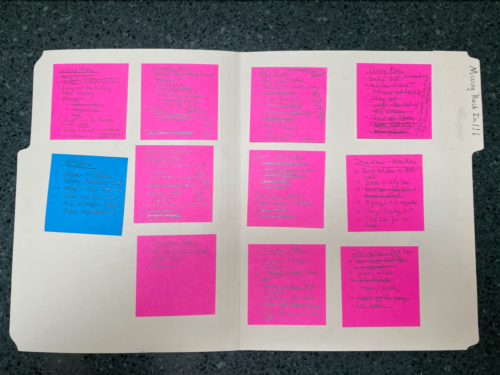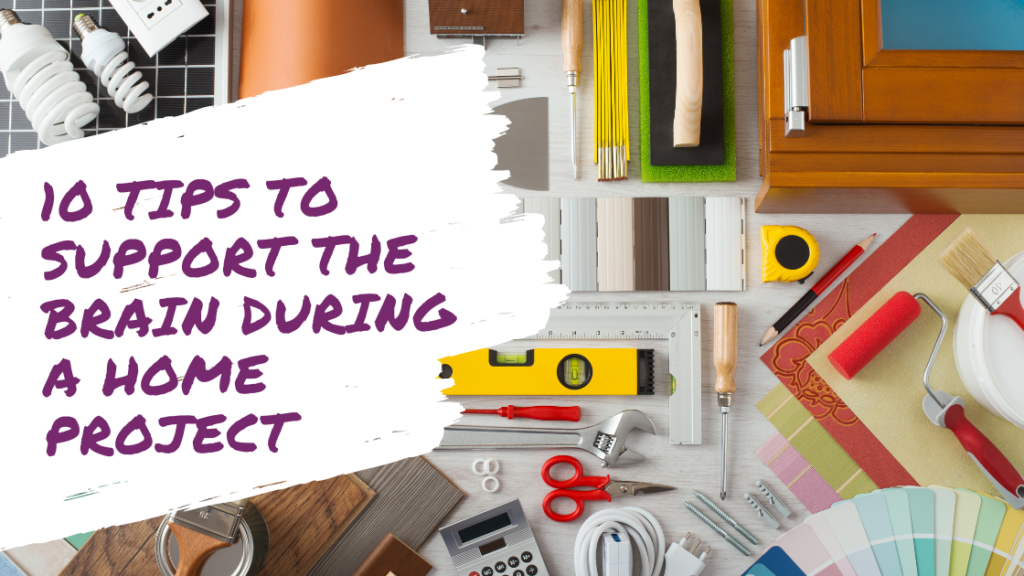I have been thinking a lot lately about the executive functions required for the management of a home, especially related to home projects.
When parents join their students for a Seeing My Time course, the adults often focus on piles that are driving them crazy. From a brain perspective, it makes sense that we want to handle those piles because our brains are happier in an environment that is organized by categories. Piles can actually raise the level of the stress hormone, cortisol. This brain research supports my quote in the Seeing My Time workbook: “A mess outside your body creates a mess inside your mind.”
Well folks, in February this year, my poor mind became a real mess. That’s when we started a major house renovation that turned my home of 35 years upside down and inside out. Juggling the demands of work and my role in the renovation, coupled with piles everywhere stressed my brain to the point that my executive functioning was faltering. But, I made it through and so did my husband: he didn’t leave!
Since I have now (nearly) made it through to the other side, I wanted to share what has worked well for me, so you can benefit from what I learned throughout this process! These tips could apply to a renovation, but also to a moving transition, interior decorating or even a big organizing project. Having these strategies handy will help support your brain as you work through the transition or project.
10 Tips to Support the Brain During a Home Project
1. Use your paper calendar to see the days/weeks/months required to complete your project. Break the project into steps. Put the steps on removable flags in your planner. These flags work well because plans always change, and being able to move them makes it easy to have flexible thinking. For bigger home projects add 1-2+ months to your completion date. Expect the unexpected!
2. Use a whiteboard to jot down your questions and to-do list for any contractor who is helping you on your project. This will aid in communication and workflow completion.
3. Think ahead and place product orders early. Hold onto those receipts and order numbers. Upon arrival, check the condition of the product. It’s very sad to discover damage that occurred during shipping. Reordering can mess up your timeline.
4. Create a home for all of the important receipts and communication connected to your project. For big projects, these would include bids, contracts, payment schedules, and communication emails. The home can be digital – a labeled folder in your inbox. I prefer paper, so I made paper copies and used the back pocket in my Seeing My Time planner as the project home, which was very helpful. You can also tear out the pages in an old Seeing My Time Planner and use the cover and pockets as a home for these items. When a project is completed, file this documentation for future reference.
5. Record valuable project data including the names of all the contractors and sub-contractors, along with dates of service. (I was able to locate a service date and warranty that dated back to 1997, which was actually critical information during this project.) Record paint and stain colors and warranties for all major appliances. For the big expensive appliances, register them with the manufacturers. Put this information in your project folder that should be labeled and dated.
6. Declutter, declutter, declutter. As you empty spaces, take a hard look at everything you touch. Do you actually use it or like it anymore? When in doubt, get rid of it. If the little voice says: “But I might need this someday”, toss it!
7. Feeling overwhelmed? Do a “brain dump.” You can use posterboard, a whiteboard or just about anything for this! The point is to get everything out of your head and onto paper. I used a manilla file folder and large sticky notes. Each note represented a room or space that needed attention or organizing. The sticky notes became mini checklists. It felt so good to cross things off those notes.

8. Rethink placement. As you create new homes for things, take the time to consider each item’s logical and accessible location. Fight the urge to just put things back the way they were before. Categorize items and group them in containers for easy access. Label your organizing containers so family members know where to find things and where to put them back. This also supports your working memory!
9. Be kind to others. Treat the professionals who come into your home with kindness and respect. It’s the right thing to do! If people feel respected and appreciated, they will often go above and beyond.
10. Be kind to yourself. Escape when you need to regroup. Say “no” to requests for your time during your project. Don’t add any other projects. Be patient with yourself and your family. Projects are time and energy-consuming processes. With goal-directed persistence, you will reach the end. The port-a-potty will eventually leave your driveway!
Little By Little…Change Happens

Our renovation had a lot of unexpected “project creep” and was a huge amount of work, but it has been so worth it. There have been multiple carloads of things taken to Goodwill to become someone else’s treasures. There were two truckloads of pure junk taken to the dump. Getting rid of that all that stuff has created welcome space in both my home and my brain. It also made my adult children happy. They are thankful for my future thinking. There will less for them to handle later down the road.
But the greatest joy is in my kitchen, which is my “happy place.” I will no longer be climbing a ladder to get to cake pans that would start falling on my head. I don’t have to get on my knees to reach a particular pan stashed behind a pile of other pans. I no longer have to worry about my baking drawer, full of heavy flours and grains, collapsing onto my feet due to the weight. And no more wondering what is actually stashed behind ingredients on a shelf. Short little me can reach and see everything I need. It is heaven. My brain is so peaceful and happy with all this thoughtful organization.
So, what home project have you been avoiding? I hope these tips and tools will help you to create a calm and ordered home. Your brain deserves it!
Little by little,
Marydee


Thanks for the tips! ? Thinking of a major move (out of state) and the thought of moving terrifies me (especially since my husband and I are both seniors with a disabled adult daughter).? All three of us have ADD with executive functioning problems of some kind (and degree).? Yikes!?
Hi Pamela, Glad that the tips are helpful to you. As a senior myself, I encourage you to write everything down and keep it in a notebook that is big enough and bright enough that you can find it easily. You can do this move. Little by little…Stay well.